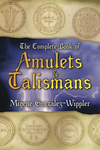Talismanic Magick

Talismans are powerful magickal tools that anyone can use. Many books, however, aren't very clear as to what they are and how they're used. In Modern Magick, I define a talisman as "any object, sacred or profane, with or without appropriate symbols, that has been charged or consecrated by appropriate means and made to serve a specific end." Let me break this definition down for you:
- A talisman is a physical object, not merely an idea or concept.
- It can be a sacred object, such as a cross or a pentacle, or it can be something with no obvious spiritual connection such as a favorite ring, pendant, or even a piece of paper.
- It may have symbols or writing on it, but that is not a necessity.
- What is a necessity is that energy must be put into the talisman to charge or consecrate it.
- It must have a specific purpose. Such a purpose can be general (such as health) or specific (to get a certain job).
In Modern Sex Magick (which covers far more than just sex magick), I describe the physical forms talismans can take:
- Prefab Talismans: These are the type you find already constructed and available for purchase through stores.
- Found Talismans: These are objects which you find, purchase, are given, etc., that are not designed to be talismans, but which you decide to use as talismans. An example of this might be a ring or a seashell.
- Traditionally Structured Talismans: Over the eons, various traditions concerning the construction of talismans have been developed. Extended instructions for constructing these, using such things as Kabalistic techniques, numerology, and traditional symbols, are given in Modern Magick. The main difference between traditionally structured talismans and prefab talismans is that you make the traditionally structured talismans yourself rather than purchasing them in a finished form. They can also be far more specific to your needs. A popular technique, centered on the idea of compressing the letters of a word or phrase indicating the purpose of your talisman into a single symbol, is an example of such a talisman.
- Freeform Talisman: One of the most popular ways of communicating with the non-physical world has been through automatic writing. With this form of communication, you let your mind to go blank and allow spirits to use your arm in order to write a message. Some people have used this to write entire books. There have been variations on this, including a type of automatic typewriter. Perhaps the most popular form of automatic writing is the ever-popular Ouija® board and its variations. One twentieth-century occultist, Austin Osman Spare (1886–1956), was also a brilliant artist. He developed a process called automatic drawing. Although more than one critic said the works he did while using this process were inferior to his other work and lacking discipline, that misses the point. They don't look like his other styles because they are otherworldly. And you can use this to great effect.
Resources
The subject of talismans obviously goes much farther than what I've shared here. Beside the books already mentioned, there are a few other books that are especially excellent resources, no matter your level of magickal experience.
Amulets & Talismans for Beginners by the authoritative and prolific Richard Webster is a great place to start. In an easy, step-by-step manner, you'll learn how to create, charge, purify, and empower your own personal magical objects for a variety of purposes, from attracting love to attaining wealth. You'll learn about protective amulets from around the world, including previously unpublished information on yantras, a form of talisman that is popular in India. This book includes a dictionary of lucky charms, from acorns to wishbones.
When you're ready to look a bit deeper into the subject, I suggest occultist Nick Farrell's book Making Talismans.
In this unique book, Farrell combines techniques from areas as diverse as Shamanism, Paganism, the Hermetic Order of the Golden Dawn and the teachings of Dion Fortune. He provides training in a variety of magical techniques, ranging from the simplest to the most complex. With these clear instructions, anyone can become capable of performing advanced magical talismanic operations. Whatever your magical tradition—Wiccan, Pagan, or ceremonial—Making Talismans provides you with all the necessary practical information and techniques for creating these potent magical objects.
Finally, for anyone who wants a complete education on the subject, a must-have book is The Complete Book of Amulets and Talismans by Migene González-Wippler. This is easily the most thorough book on the subject published in recent history. It is unmatched in its depth, and is written from a contemporary point of view, making it easy for you to understand and use. It includes a brief overview of working talismanic theory, and includes a history of talismans from Babylon, Assyria, Israel, Egypt, Phoenicia, Greece, Rome, and those of the Gnostics. The book covers how to make talismans from the traditions of Voodoo, the Pennsylvania Dutch, Native Americans, Hindus, and Tibetans. Covering more than mere historical accounts, it shows you how to make and use your own talismans using a wide variety of techniques.
Charging The Talismans
Unlike talismans you buy, making a talisman tends to give it a magickal charge. However, doing a ritual to charge it really gives it a powerful jolt. Here is a brief outline for doing a talisman charging ritual:
- Relax.
- Perform your favorite banishing. Build up a magickal energy charge. You can do this by performing slow, deep breathing while visualizing energy coming into you with each breath. Repeat until you are crackling with energy. Hold the talisman in your left hand.
- Send the energy. When you simply can't build up the energy any more, hold your right hand over the talisman in your left. With an exhalation, visualize all of the energy you've built up going down your arm into the talisman. As you do, think of the purpose of the talisman. You may even want to shout out the purpose of the talisman.
- Seal the energy. Obviously, you don't want the energy you've put into the talisman to either dissipate or return to you. To seal the energy into the talisman, put it down and clap your hands and stomp your feet. This seals the energy pathways that could redirect the energy into your body, while the sounds change the environment of magickal power from being open to being closed.
- Keep the talisman with you until it achieves its goal, then burn it and toss the ashes into the air to dispose of them.

About Donald Michael Kraig
Related Products


is subject to certain Terms and Conditions